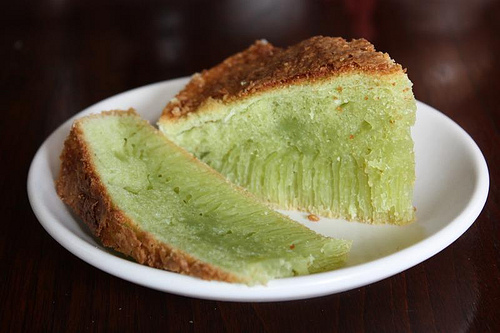
This is one of the strangest things I’ve ever baked. I went three rounds with it as part of a small project with Thu N., who emailed me a while back asking for help in making one of her favorite Vietnamese sweets. If you’re not familiar with banh bo nuong, it’s a chewy, coconutty green cake often sold as slices on Styrofoam trays at Vietnamese bakeries. The color and tropical, grassy notes come from pandan leaves (la dua).
Banh bo hap refers to the Chinese steamed rice cake (bái táng gāo, 白糖糕) that’s sometimes available at dim sum house. Banh bo nuong is the Vietnamese baked version that doesn’t require days of fermentation. It’s supposedly fast to make but it’s taken me a while to figure things out.
The cake is tricky because there is no gluten in it and you have to get it to rise. Additionally, a good banh bo nuong has striations in the cake from the heat pushing through the batter. Those vertical channels – which you see above – are sometimes described as honeycombs, which is why banh bo nuong can be translated as “honeycomb cake.” I see geologic patterns more than patterns formed by busy bees. Ants dig channels like those, right?
So, I’m here to report to you my progress on three (3!) tries. I think you may get a laugh or two, maybe more. Thu’s problem was this: her banh bo nuong was not rising properly in the middle to form the desired ‘honeycomb’ pattern.
The Devil in too many details
There are just a handful of ingredients in this cake -- tapioca starch, sugar, coconut milk or cream, pandan extract, eggs, and leavening. To help Thu, I looked online for a recipe and found several banh bo nuong recipes that specified using single-acting baking powder sold at Vietnamese markets. That’s the pinkish Alsa envelopes below. My mom dug up a recipe from her friend’s daughter that called for Alsa and vanilla sugar, also sold at Vietnamese markets. Some recipes specify a particular brand of tapioca starch too. Below is what I typically use, the 3-headed elephant. Additionally, there was the holiday green pandan extract and a warning to avoid using coconut milk and instead use the thick cream.
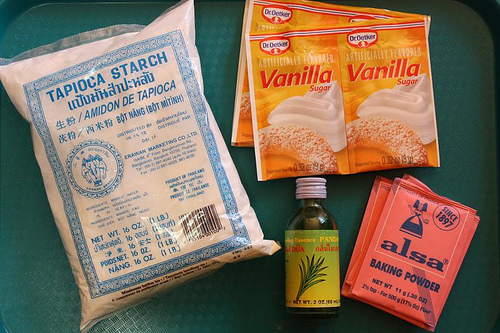
Beyond the “you must use this” there were many “you must do that” or your cake won’t rise and bake properly. For example, don’t stir the batter too much. Strain the batter. Let the batter sit for 20 minutes. Preheat the cake pan in the oven. Regulate the oven temperate from high to low. Use a moderate oven temperature. Many people have made this cake at home, and needed to assist Thu, who was pinging me with her progress.
Banh Bo Nuong #1
I gave the recipe from my mom’s friend a try. I made a special trip to Lion market for Alsa single acting baking powder and the Dr. Oetker vanilla sugar. I followed the recipe instructions to what I thought was a “T” but the first cake was frankly, an unmitigated disaster. It took the longest time to rise and I baked the darn thing for 1 ½ hours!
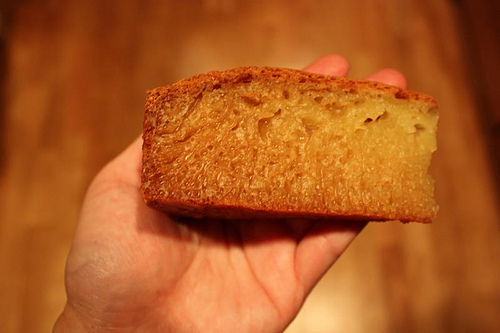
The green pandan extract turned brown from all that baking. I sent Thu the above photo and she kindly said that it looked nice. I took a bite from that slice and it was rubbery and tasted metallic, most likely from the Alsa baking powder. Worse than all of that – the thing was heavy enough to use as a doorstop or even the rock for a curling competition! I threw banh bo nuong #1 out.
Banh Bo Nuong #2
I reached out to my friend, Terrence Khuu, a San Francisco-based chef. He got his mom’s recipe for me and cryptically sent it via Facebook. Terrence said that she’d been making really good ones that he’d been eating up and getting fat from. Sounded good to me. Mrs. Khuu surprisingly used a 1:1 ratio of tapioca starch and har gow dumpling mix (bot ha cao) that she bought at the Vietnamese market. Terrence sent me a photo of the mix.
Mrs. Khuu did not use Alsa baking powder and food coloring. She simply stirred the ingredients together and baked for 40-45 minutes. I trusted Mrs. Khuu but didn’t buy the dumpling mix. After all the recipe developing for the Asian Dumplings cookbook, I knew that the mix was mostly wheat starch. So I used a 1:1:1 ratio of wheat starch to tapioca starch to coconut cream. I preheated the pan in the oven for about 15 minutes and the cake didn’t rise much at the edge. It seized up instead and deflated a tad after baking.
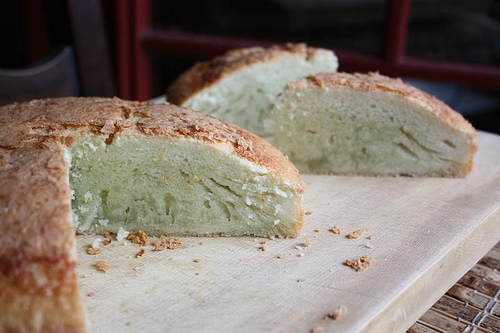
The cake baked okay but it cracked and weighed just a little less than a doorstop. The pandan extract’s chemically flavor shot right through the tapioca and wheat starches. No wonder Mrs. Khuu didn’t use the pandan extract. Cake #2 went into the trash with a thud.
Banh Bo Nuong #3
I dumped the pandan extract and decided to extract from scratch. I’d done it before with water but this time, used the thin liquid from the canned coconut milk. I chose Aroy-D brand in a box because it’s exactly 1 cup – what I needed for the recipe. Boxed coconut milk and cream are fresher tasting than canned. So I whirred it up and squeezed things dry. Then I stirred all the ingredients together and poured the avocado green batter into a parchment paper-lined baking pan. Into the oven it went for about 45 minutes.
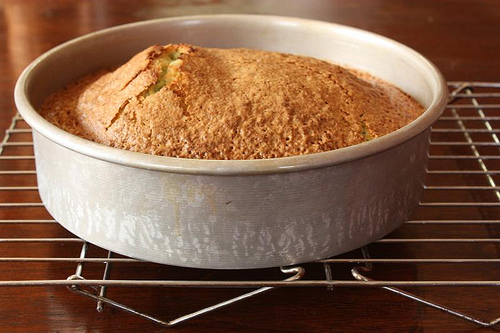
The resulting cake looked like the Elephant Man with that bump you see. Was my oven heat THAT uneven? I let the cake cool and when I went to unmold it, it WOULD NOT come out. I thought I’d lost it. Then I cut and pried out a wedge of the cake. It was gloriously green, not lead-like in weight, and had the vertical honeycomb trenches. I was all smiles! But, the parchment paper was nowhere.
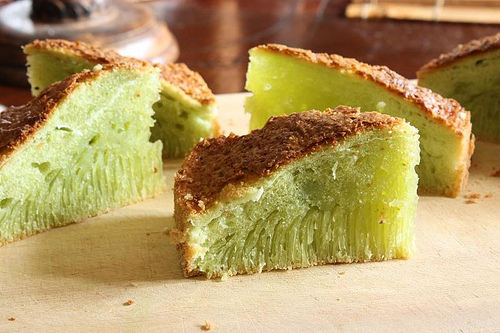
Suddenly, I realized that most of the batter had baked underneath the parchment. The parchment was actually under the crumbly top of the cake! I don’t know if that was because I moved the pan to take the photo or if the direction of heat flow in the batter during baking caused the paper to rise like that. The bump in the cake was caused by an undulation in the parchment paper that is visible below:
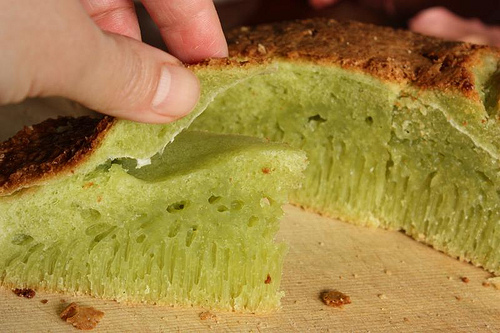
In any event, it was the most bizarre baking experience I’d ever had. The cake tasted good and wasn’t as rubbery as an all-tapioca cake. But not having the top of the cake attached was weird. Sometimes, the simplest foods can be the hardest to master.
I think that the recipe is pretty much there but I don’t have the time right now to give it another go. Plus, I depleted my inventory of frozen pandan leaves. But on the next try, I won’t line the pan and hope for the best. Until then, here’s the recipe for you to give it a whirl.
Recipe
Pandan and Coconut Tapioca Cake
Banh Bo Nuong
If you don’t have this brand of coconut milk (I got mine at Ranch 99 in a six-pack), use regular canned coconut milk. You want about ½ cup of the thin coconut milk and ½ cup of the thicker cream. Extracting the pandan in the thin milk is easier to work with. The tapioca and wheat starch are both Asian market items. As for the baking powder, it’s just the regular double acting kind you’d find at a supermarket.
Makes 1 cake, enough for 8
1 (8.5 -ounce) box coconut milk, Aroy-D brand preferred
½ cup packed chopped, thawed pandan leaves (about 1 ¾ ounces)
4 large eggs
1 cup tapioca starch
1 cup wheat starch
¼ teaspoon salt
1 ½ cups sugar
2 teaspoons baking powder
1. Position a rack in the middle of the oven and preheat it to 400F. Oil a high-sided 8-inch round cake pan.
2. Separate the thin from the thick coconut milk. Set aside the thick milk. Use a mini food processor to grind the thinner milk with the pandan.
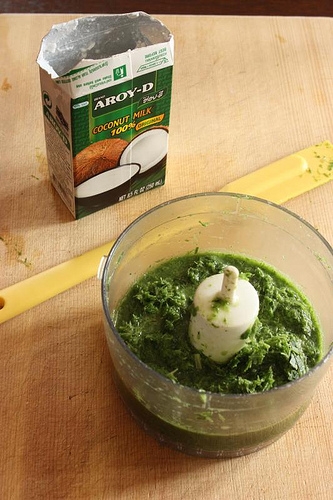
Then extract the green liquid through a piece of muslin, squeezing as much out as you can. (See this post on pandan for guidance.) Whisk in the reserved coconut cream. Then combine with the eggs, whisking until well incorporated.
3. In a bowl, combine the tapioca starch, wheat starch, salt, sugar, and baking powder. Make a well in the center, then whisk in the liquid ingredients. If the batter is lumpy, pour it through a coarse mesh strainer.
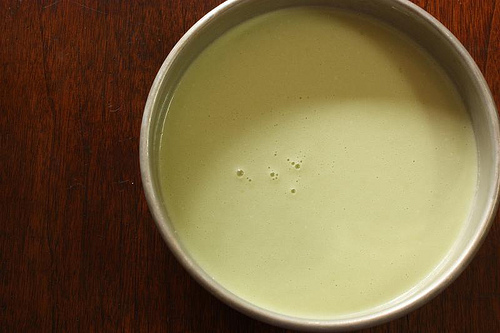
4. Pour the batter into the prepared cake pan and slide it into the oven. Bake for about 45 minutes, until a toothpick inserted comes out fairly dry. There may be a little dampness at the bottom of the cake. Cool on a rack before running a knife around the edge and unmolding.
Good luck and let me know how you do with this recipe! Or, maybe you have experience baking banh bo nuong and want to share your insights? Perhaps you know why the cake bakes up with the vertical striations?
















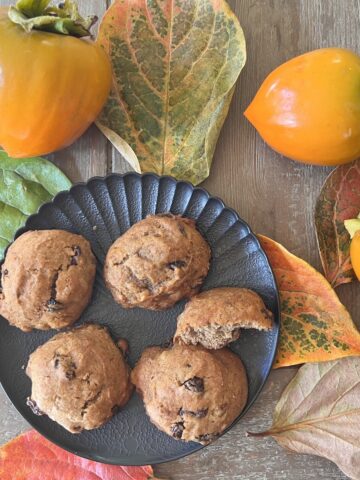
Danielle says
I never even thought to give this a try at home. The Styrofoam-packaged cakes at local Vietnamese bakeries and sandwich shops are usually so cheap and work so well as a quick pay-and-go item. Kudos to you for giving it a whirl, and three times no less! I'll ask my mom and sister-in-law if they've ever tried making this cake. 🙂
Belinda @zomppa says
The texture looks so inviting! I'm not sure I dare to ever try this myself. Can I just come over
Eve says
Somehow it's comforting to know that even the most amazing cooks have screw-ups and trial-and-error sessions.
I am very amused by the wandering parchment though (perhaps a silicone cake pan would work better - they rarely stick). It reminds me slightly of a pudding/cake/dessert dish I loved when I was little - you mix up what's essentially a cake batter (usually chocolate) and put it in a baking dish, then pour over hot water and bake. It looks like a Superfund site going in, but comes out as a cake floating on a sea of custard. I think I'm just a stovetop cook at heart - I know exactly what's in my wok, but ovens are mysterious black boxes where anything can happen once the door's been closed.
(I bet a pandan-and-coconut or maybe lime-and-coconut version of that pudding/cake/dessert would be great, now I think about it.)
Sandy says
I had a conversation with some friends recently about the Chinese white sugar cakes. No one ever remembered their moms or grandmas making it at home; everyone always bought it at the bakery or store.
I bought lots of packets of the German vanilla sugar when I was in Germany this summer because it's so inexpensive (A package of 10 packets was less than 1 euro). I usually use this in flan and other desserts (but I won't be tackling this one!).
Andrea Nguyen says
Goodness, I screw up lots in the kitchen and persist. With each discarded cake and piece of parchment stuck to my teeth, I learned something new. There are takeaways in these experiments. I'm glad that my husband finds me so amusing!
Quyen says
I've also tried different recipes and still couldn't get it right. Seeing what you've shown I feel like you're telling my own experience, especially the parchment paper, bizarre isn't it?
I am not so keen to try again for this cake. Looking forward to your next try. Cheers
Shuku says
Andrea, I just took a look through the recipe you posted. The Chinese 'bak tong kou' you mentioned actually uses rice flour and yeast - I wonder if that would help put the holes and channels in. I've not made it myself yet even though I've been meaning to, but I thought it might be interesting for you to see, in the interests of research. This is the recipe I've been hoarding:
http://roseskitchen.wordpress.com/2007/02/27/pak-tong-kou-steamed-white-cake/
Kimberlea says
This is one of the hardest things to bake, ever. I have one recipe, yet every single time I make it, the results are different, and I have no idea why. The recipe I have just calls for tapioca flour only, and that you have to pour it through a mesh strainer into the pan right before baking, although I think it doesn't matter since the batter is so liquidy. I have found though, that I had more success with the pandan extract rather than extracting it from fresh leaves, which is the opposite of what worked for you. My last several tries were disasters, and so I gave up...but your post is making me think about giving it another go.
Annette says
I tried to make this cake many times and finally I got it down. Here is the link to my recipe:
http://vietspices.blogspot.com/2010/10/banh-bo-nuong-honey-combs-cake.html
Rosely says
I remember my mom use to try to bake this, it would turn out so chewy! I've always liked the plain white banh bo better. Great palette cleanser after alot of fattening chinese food.
OysterCulture says
I am so intrigued, I am going to try to give this a try. Hopefully I can jump straight to three and not pass through 1 and 2.
Thenewartofbaking.blogspot.com says
In Malaysia, we have a similar looking cake called Kuih Sarang Semut, which also translates to Honeycomb cake. However, we only use all purpose flour to make the cake and nothing fancy to it. The key is the caramel sauce.
I have made this using the recipe below and it came out great. You can of course add pandan flavoring to it.
http://sunflower-recipes.blogspot.com/2008/09/kuih-sarang-semut-honeycomb-cake.html
kittybert says
i've been trying many different recipes to make banh bo nuong. i keep having the problem of no or very little bottom and side crust as well as, it smells very flour-y which permeates the cake and makes it not taste good. any idea on what may be the problem?
Women Jordans says
Sometimes a rumour is like a snowball. It will become bigger and bigger, especially on the internet
Belle says
Hey, I was wondering if there's any alternate names for wheat starch. I can't seem to find it here. Or is there, perhaps a substitute for it?
Thank you!
Tapioca Starch says
Tapioca and its derivatives such as modified tapioca starch are often used as thickening, texturing and stabilizing agents. Modified tapioca starch promotes a good shelf life in dairy desserts, cream fillings and canned or frozen foods.
snowy says
Thank you for sharing. I've had 3 failed attempts (with 3 different recipes)at making this. Very tragic. They all tasted terrible, did not have a tinge of green, and were lead weights. I'm going to give this recipe a try. Not defeated yet!
Frida says
Love your site... anyway, this cake is very similar like cake in Indonesia. We call it Bika Ambon. I will try to make it this weekend... Thank you!!!
Gordon says
This is a fabulous site, you have a wonderful selection of great recipes and food ideas. Thanks so much for this post and all the others i will no doubt try over the years.
Amy says
Inspired by your blog, I've tried out Banh Bo Nuong for the very first time with success! I collected various tips from various sites and came up with what I think is a fool-proof recipe.
See my journey at http://justfortheheckofit.blogspot.com/2011/10/banh-bo-nuong.html
Beats by Dr Dre says
Misfortunes come on wings and depart on foot.
Canada Goose says
A little pot is soon hot.
seo service says
This is the best bowl of pasta I’ve ever eaten. EVAR. Very light, simple, but perfect in every way. In fact, this was so good that we went to the book store after our meal and scoured through all of his books so that I could get the recipe. I think that the simpler the dish is, the easier it is to eff up in execution, but they managed to pull this one beautifully.
marlon says
This is a fabulous site, you have a wonderful selection of great recipes and food ideas.
Miss Kimbers @ Fruit Salad and Mixed Veg says
You are very ambitious and I applaud your many attempts at this cake:) Unlike me, you do not let one bad recipe stop you from mastering the cake. The last cake looks so yummy. I am too scared to make it but I would really like to try it:)
Mai Nguyen says
Dear chi. Andrea,
I finally succeeded the third time around. It came out looking good, tasting great. The first two times I used other baking powder so looks like that's the culprit. I followed your recipe except I used Savoy coconut cream, 1 sachet of Alsa and I just greased the pan and didn't use parchment. Thanks for this recipe. I searched high and low and yours is the only one that uses real pandan leaves which I like.
QP says
Dear Andrea,
My cake turned out 90% deflated after taking out of oven and no honeycomb 🙁 I'll try with a single-acting baking powder next time to see how it turns out. I don't live in the US so it's impossible to buy Alsa - meaning I'll have to make my own single-acting baking powder 🙁
Jennifer Kuo says
I'm from OC and for the life of me I can't seem to find pandan leaves. Which Asian supermarkets I've hit up a few and didn't see to find any in the frozen food section.
mai says
My mom leaves the cake mixture out for about 30 to an hour and hers has beautiful texture and the pretty lines too.